Dealing with issues from pesky ivy vines on your property? Learn how to get rid of ivy once and for all with our guide.
The first most important thing to clear up is that this article will be talking about ivy vines, NOT poison ivy which causes rashes all over your body.
Ivy can be grown into your garden landscape as an ornamental feature, but it can also prove to be invasive and even dangerous to your property. Ivy infestations can take over a landscape and removing ivy from trees can become extremely difficult, particularly the vines that grow higher.
While vines can be a beautiful feature on your property, they need to be properly maintained. Problems may not seem serious until the plants have already overtaken your lawn or garden and the trees within it.
So before this problem in your lawn or garden becomes more than you can manage, you should read this article.
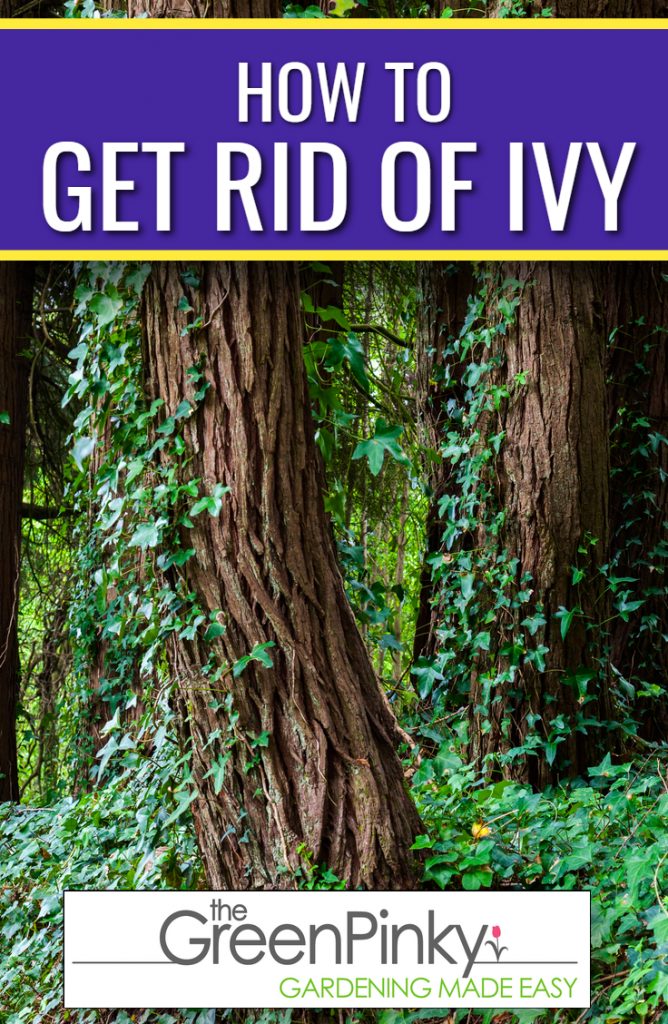
What is It?
English ivy, or Hedera helix, is the most common form of it found around the country today. English ivy is a plant of climbing vines with smooth and shiny evergreen leaves, small yellowish flowers, and black berries.
It grows at an aggressive rate. If left unchecked, it can grow up from a tree trunk to heights between 50′ and 100′. While it is primarily a climbing vine, it also acts as ground cover in some instances.
English ivy is conditioned to tolerate a wide variety of growing conditions. It can grow in full shade or full sunlight. The English variety can grow roots in nearly any soil type, but it prefers well-drained soils.
Ornamentally, this plant can be used as a cover for fences, trellises, or walls. It can also be used as an ornamental ground cover and, in this form, rarely needs to be pruned unless it grows into unintended areas of your lawn or garden.
Invasive Plants
Ivy plants may have no natural enemies in their environment to control their growth. If this is the case, it can become invasive plants in your lawn or garden. An “invasive” plant is one that spreads rapidly and is harmful to other native organisms in its environment. Here are some of the potential problems that infestations can cause in your garden or on your house.
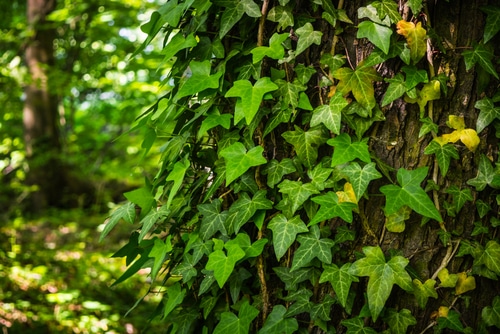
It Can Be Toxic
Ivy is mildly poisonous. People with allergies or that have endured prolonged exposure to the plant can develop dermatitis on their skin.
Effect of Vines Growing on Trees
A very dense growth of ivy may damage trees. If it grows thick enough on trees that they make them more susceptible to wind damage due to the additional surface area of the leaves acting like a sail.
If its vines is allowed to grow high enough in the trees, it can block the leaves of the tree from getting the sunlight they need for photosynthesis.
Ivy leaves will also trap water. When this happens, it makes them more susceptible to disease that could potentially spread to the tree bark.

Effect on Plants
Ground cover ivy can establish a root system in the ground and spread out to prevent light from reaching other plants’ seedlings and cause them to die.
It may also smother wildflowers and ferns because it grows so aggressively and is heartier than the other vegetation surrounding it.
Effect on Wildlife
In the wild, ivy is beneficial to the wildlife surrounding the area in which it grows. The nectar inside of the flowers is a food source for bees and butterflies.
However, if grown in your lawn or garden, it can provide a habitat for rats and other pests that you don’t want around your house.
Effect on Wooden, Stucco, or Painted Structures Around Your Home
On wooden surfaces such as your deck or fence, vines can grow between boards and open the joints. The potential for the leaves to trap water can increase the risk of wood rot. It has also been known to provide a habitat for wood-eating pests.
When you get remove it from stucco or painted walls, you run the risk of the paint chipping or the stucco coming off in chunks because of the strong manner in which the it attaches to structures.
Effect of on Brick Structures
If your house is made of older brick or the mortar of newer brick is weakened, ivy can invade into the cracks or loose bricks. Its roots grow between these cracks and it can further weaken the mortar. It does this by widening the cracks, which will allow moisture to creep into these flaws.
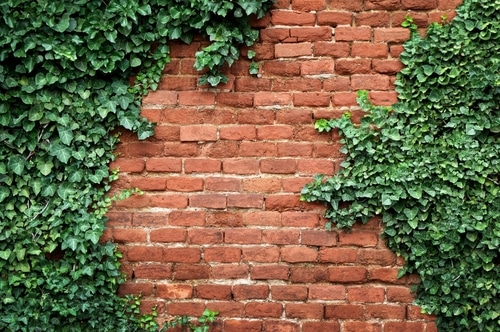
Effect on Dry-Stacked Structures
If you have mortarless stacked stone structures around your house, ivy can prove to be a problem.
Because there is no mortar, the structure is inherently full of cracks. This allows the plant to take hold in the crevices. When it comes time to get rid of it on the structure, you run the risk of pulling out individual stones. This can collapse the entire structure and potentially hurt you.
5 Different Methods of Removal
You have a couple of different methods to choose from to get rid of ivy on your property.
Method 1: Cut it Back
You should only choose this route of removal if the growth is relatively new. If it has been allowed to grow unchecked for years on your property, then it is heartier than you can imagine. At this point, the vines are no longer flimsy. They have grown into thick and woody vines that are difficult to cut and remove either from the ground level or the trees. The root system is well established in the ground and the plants have probably outgrown the landscape.
Here are the steps you can take for smaller patches of ivy with vines growing on your trees.
- Cut the vines at waist level 3’ to 4’ above the base of the trunk.
- Leave the vines that are growing on the tree to die off. This may take some time, but don’t pull them until you are confident they are dead. Pulling them before this point can damage the bark of the tree.
- Giving yourself a radius of 3′ to 4′, remove the roots of the plant by hand. This radius will provide you with enough room to remove any new roots that take hold quickly in the ground.
- Apply the same method for any vines left growing on the ground.

Method 2: Apply Herbicide or Weed Killer
When removing ivy from your home’s walls or other structures around your lawn or garden, the application of an herbicide or weed killer to the roots will prove helpful to kill it.
You should pull each vine gently off the wall to avoid damaging it. Using a garden sprayer or spray bottle, apply weed killer to the roots to prevent it from growing back again.
The roots may not die with the first application because these plants are incredibly hearty. To completely kill ivy, you should check back periodically in the area you have treated with weed killer. If you find that you did not completely kill the plant roots, apply the weed killer again. Repeat this process until you are sure the plants’ roots are dead.
Method 3: Solarization
Sometimes you cannot kill ivy by cutting it back or with weed killer because its vines have grown too thick and hearty to be removed easily.
If you find this is the case, solarization may be your only option.
You can kill ivy with solarization by covering the plant completely with thick black plastic sheeting. Once you have the it completely covered, you need to stake its edges down or place something heavy on it to hold it into place.
Over time, the ivy will cook underneath the plastic and suffocate.
If you choose this method, be prepared for a long wait. Depending on the vine’s thickness, this process takes up to 2 years to completely kill it.
Method 4: Apply White Vinegar
If you aren’t a fan of using toxic chemicals on your lawn, then white vinegar may be a better option for you.
The acid content of white vinegar makes it a safe, non-toxic way of getting rid of it.
If you are using a garden sprayer, make sure that you flush it with water several times to remove any weed killer remaining inside from prior use. A garden sprayer can be used for larger patches of ivy in your yard. For a smaller patches, you can use a simple spray bottle.
You should spray the white vinegar thoroughly on the vines. Take extra care to only spray what you intend to kill as white vinegar is non-selective.
After one week, you can come back and observe the effects of the white vinegar. Remove the dead plant that you see in the area (dead ivy will appear brown).
If there are still areas that are alive, you can respray it thoroughly. Return in a week and repeat the process if necessary.

Method 5: Apply a Salt and Soap Combination
Another safe way of removal is by mixing 1 cup of salt and 1 tablespoon of liquid soap into a gallon of water. Using a garden sprayer or spray bottle, spray it at the invasive plant.
Use the same process and time frame as you would if you chose to use white vinegar.
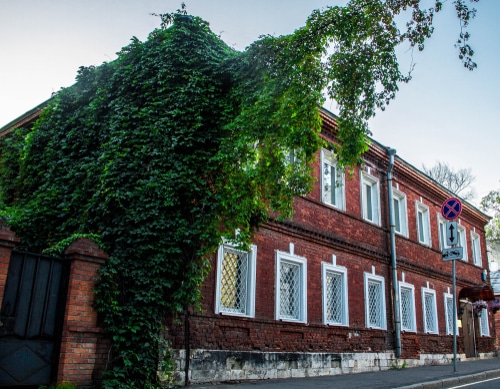
Additional Tips and Considerations
When deciding how to get rid of ivy growing around your home or garden, you should always keep in mind some things.
- You should always use personal protection like gardening gloves and glasses.
- If using a garden sprayer, make sure you rinse it to clean it of any herbicide or weed killer.
- If you decide to use white vinegar, remember that it is non-selective and will harm other vegetation.
- Place dead plant and debris in a trash bag and tie it up. Remember that some poison from the ivy or herbicide might remain on the leaves and can be harmful to your skin.

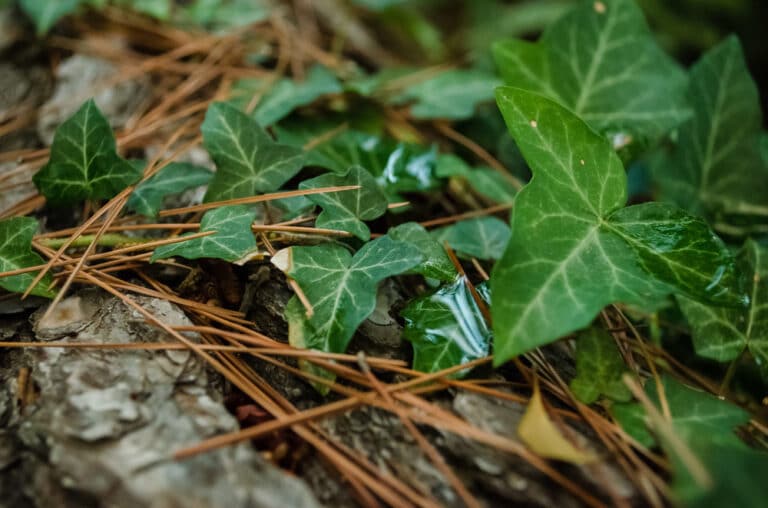
I am currently implementing the solarization plastic sheeting method because it seemed like the easiest least time consuming way to stop the ivy from continuing to take over my yard but I’m concerned about the roots of a huge maple tree that provides so much shade to my house that it will be damaged from the solarization method. The plastic also prevents rain from penetrating to the roots. Should I pull up the plastic and choose a different method?